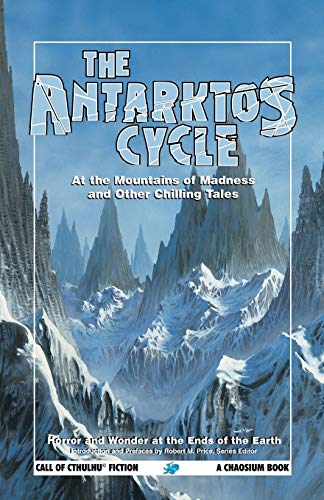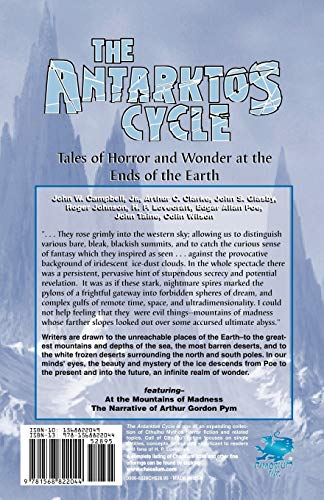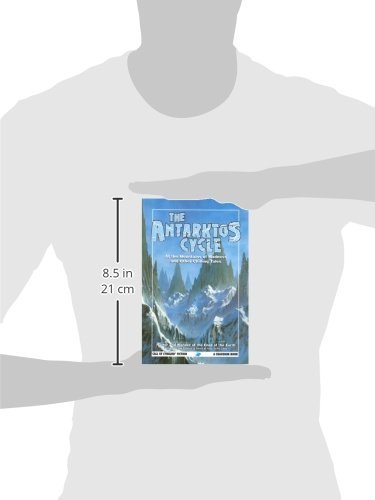Customer Services
Copyright © 2025 Desertcart Holdings Limited
Desert Online General Trading LLC
Dubai, United Arab Emirates




Full description not available
M**L
A good read of escapist adventure stories of ancient astronauts and extinct cities.
I have the 1999 edition which seems to be no longer in the Amazon catalog. I also suspect the 2006 edition drops the Jules Verne "The Sphinx of the Ice Fields" which is only excerpts and does not fit in the horror and wonder theme of the rest of the stories. The whole novel is published as The Sphinx of the Ice Realm (Excelsior Editions). The novel is rather mundane compared to the other selections of The Antarktos Cycle. Some of the stories here, such as The Dreaming City by Roger Johnson are not even set in Antarctica, but in the Gobi Desert of Mongolia. The Dreaming City drives people insane. At first an interesting archaeological adventure but the narration is so subdued and vague that it fails to interest the reader. Also this story tended to recycle The Brooding City by John Glasby and At the Mountains of Madness by Lovecraft and The Invisible City, by Clark Ashton Smith -- not found in The Antarktos Cycle -- it is one of many stories of archaeologists discovering a ruined city. The story fails because of lack of a compelling narrative. I liked best The Greatest Adventure by John Taine. It had memorable characters and a compelling plot. At the Mountains of Madness by Lovecraft was also quite good, but somehow not the wondrous read I had been expecting. Then the stories in this anthology go downhill. The Tomb of the Old Ones, by Colin Wilson, was disappointing. The Thing from Another World by John W. Campbell, was not very good at all, it seems too jumpy and lacked character development. The Brooding City, by Glasby, was too short to get into the characters and seemed to be underwritten. It seems the farther into the book the worse the stories got. The first selection, The Narrative of Arthur Gordon Pym was the best-- but I have read that one many, many times elsewhere so I skipped it this time around. The Sphinx of the Ice Fields was not bad, but does not fit into the theme, as it is not supernatural but purely mundane, as it was mere fragments. It cannot be considered to be a Cthulhu story. Furthermore, The Brooding City and The Dreaming City are not set in Antarctica, both are set in Mongolia, so why are they here? Yet for the most part a good read. Escapist adventure stories set far away with ancient astronauts and cyclopean extinct cities. Worth 4 stars.
D**K
The mysteries and terrors of the Seventh Continent
This is an exceptionally good and well thought collection of stories linked to the lovecraftian mythos. I did not like the two first Chaosium collections which I read ("Necronomicon" and "Ithaqua cycle"), but this one I found excellent. I must however confess that I am not entirely objective, because for some irrational reason I have a particular weakness for stories which action is situated in Antarctica - and that may explain in part why I liked this book so much.The great idea of Robert Price (editor of Chaosium books) was to take one of the key texts by Lovecraft himself ("At the mountains of madness") and make it the central piece of a collection by choosing both texts which inspired Lovecraft and those that were inspired by his story. This gave quite a unique collection, of great quality. Below you will find more details about the stories, with some limited SPOILERS:"The narrative of Arthur Gordon Pym of Nantucket" by Edgar Allan Poe - this very old and very classical text (first published in 1838) was without the slightest doubt an inspiration for Lovecraft's story; especially it is there that is first heard the ominous sinister call "Tekeli-li! Tekeli-li!", which takes such a significance in "At the mountains of madness".Poe's story is quite long (136 pages) and in fact is rather a short novel (the only novel by this author), but it is a very good text and keeps the reader interested until the end. In places it looks as if it also inspired some of Robert Louis Stevenson and Jules Verne books and it even bears some resemblance to Herman Melville's "Moby Dick" (published in 1851), as in both cases we have a whaling ship which sails towards a lot of trouble..."The greatest adventure" by John Taine - the real name of this author was Eric Temple Bell and his daytime job was professor of mathematics; however, as John Taine, he also published, between 1924 and 1954, thirteen SF novels; this particular text appeared in print in 1929, two years before Lovecraft's story. At 138 pages "The greatest adventure" is also a short novel, rather than a story; it is however also very well written and interesting.The atmosphere here is very different from both Poe's and Lovecraft's texts and reminded me much more of Jules Verne novels; the characters are extremely colourful - a wise although eccentric American scientist, who reminded me greatly of Cyrus Smith from "Treasure Island"; his gorgeous, fearless and clever daughter; his incredibly clumsy and somehow odd but genius young assistant; a burly Scandinavian sea wolf who sailed the seven seas and have seen it all and more; and last but not least an equally Scandinavian overweight, deeply religious and surprisingly intellectual first officer. Also like in Jules Verne books, although the adventures are very dramatic, the tone is very frequently humoristic. This story was clearly an even more direct influence on Lovecraft, as it is well described in the introduction by Robert Price and both stories share a great number of similitudes. "At the mountains of madness" appeared in print in 1931, barely two years after "The greatest adventure"."At the mountains of madness" by Howard Phillips Lovecraft - well, that 85 pages long story doesn't really need any presentation, does it? Even if you already read it and know it by heart, it is always a pleasure to read it again. And if you didn't read it yet, well, in a certain way I envy you, because reading any Lovecraft's text (and especially this one) for the first time is a major intellectual experience - which is no more accessible to ones like me..."The tomb of the Old Ones" by Colin Wilson - in a certain way this 93 pages long story, written in 1999 and appearing for the first time in this collection, is a sequel to the "At the mountains of madness", so my advice would be to read it only if you are already familiar with Lovecraft's text. It is a very honest story, which gives us especially some more insight into the mysterious and terrifying "shoggoth" creatures, which usually are just mentioned in the shortest possible way (and with a shiver of terror) in most stories inspired by lovecraftian mythos. However it can not be - obviously - as good as the original story, so do not expect too much."At the mountains of murkiness" by Arthur C. Clarke - this very short (7 pages) but absolutely delicious little text written in 1973 reveals two little known things about the legendary (and regretted) author of "2001: A Space Odyssey" - he was a great fan of H.P. Lovecraft and he used to write also some absolutely not serious short stories; this one, inspired very directly by "At the mountains of madness", made me laugh out loud and I re-read it two times to savour it fully"The thing from another world" by John W. Campbell Jr. - this absolutely classical story published first time in 1938 didn't age AT ALL and even if you saw already one or both of the movies it inspired, I guarantee that it will still surprise you! I admit (with shame) that I did not read it before this year and at the end of the lecture I was absolutely impressed!This text is not connected in any way to lovecraftian mythos, it is in fact a classical (in all the meanings) SF story, but both the place of action (Antarctica) and the fundamentally evil nature of the alien "thing" make that it definitely belongs in that collection. However I also believe that the author was probably at least a little influenced by Lovecraft's story, as both texts concern the discovery of incredibly ancient artefacts frozen in glaciers of Antarctica by scientists. In fact, it takes only the slightest effort of imagination to consider the "thing" as one of the minions of the dreadful Ancient Ones, who once ruled our Earth and who will rule it again when "the stars are right"..."The brooding city" by John S. Glasby - this story, first published in 1990, is certainly lovecraftian, but otherwise it is not connected in any way with the previous ones. The action takes place in Africa and frankly, this is just another story about a lost and forgotten city with some dark secrets. I considered it just as a free sample allowing me to discover a new writer - but it was not a very good one. Mercifully, it is also very short (14 pages)."The dreaming city" by Roger Johnson - this story was first published in 1987 and it is almost the same thing than the previous one, except that the action takes place in Mongolia and it is even shorter (9 pages), which is its only redeeming quality.Conclusion: with the exception of the two last (and short) stories, this collection is a success and it is worthy to find a place on the shelf of every fan of H. P. Lovecraft and his mythos.
Z**S
南極大陸の恐怖!クトゥルー神話南極大陸編
ラヴクラフトの「狂気の山にて」やポーの「ナンタケット島のアーサー・ゴードン・ピムの物語」が収録されているのは勿論だが、他の作品群がまた凄い。「狂気の山にて」の少し前に発表され編者のプライス博士によれば、おそらく「狂気の山にて」に影響を及ぼしたジョン・テインの「THE GREATEST ADVENTURE」は今も生存している古代生物を探す南極冒険行で、やや冗長に感じられるところもあるが口語体の読み易い文体や活発で飛行機も操縦するヒロインの存在など、「狂気の山にて」よりも現代的に感じられるところが面白い。その他には、キャンベルが書いた「遊星からの物体X」の原作に当たる短編「異世界からの物体」やアーサー・C・クラークの短いパロディ、コリン・ウイルスンがネットでのみ発表していた「狂気の山にて」の続編的なオカルト短編などなど。分厚さもさる事ながら、このラインナップを選択したプライス博士に圧倒される。
L**N
Essential
A fascinating collection of stories with great, insightful, R M Price introductions. Please buy this if you are a self respecting Lovecraft head.
Trustpilot
1 month ago
1 week ago
3 weeks ago
3 weeks ago